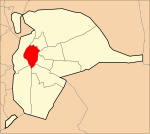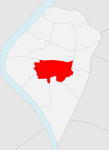Walls of Seville

The Walls of Seville (Spanish: Murallas de Sevilla) are a series of defensive walls surrounding the Old Town of Seville. The city has been surrounded by walls since the Roman period, and they were maintained and modified throughout the subsequent Visigoth, Islamic and finally Castilian periods. The walls remained intact until the 19th century, when they were partially demolished after the revolution of 1868. Some parts of the walls still exist, especially around the Alcázar of Seville and some curtain walls in the barrio de la Macarena. The walls originally had eighteen gates or points of access, four of which survive today: Puerta de la Macarena, Puerta de Córdoba, Postigo del Aceite and Postigo del Alcázar. The extant parts of the walls maintain an Almohad appearance, mixed with Classicist air resulting from restorations carried out in the 18th century.
Excerpt from the Wikipedia article Walls of Seville (License: CC BY-SA 3.0, Authors, Images).Walls of Seville
Calle Macarena, Seville Casco Antiguo
Geographical coordinates (GPS) Address Nearby Places Show on map
Geographical coordinates (GPS)
| Latitude | Longitude |
|---|---|
| N 37.401976 ° | E -5.986553 ° |
Address
Budokan
Calle Macarena
41071 Seville, Casco Antiguo
Andalusia, Spain
Open on Google Maps











